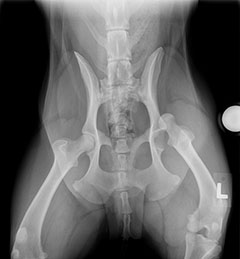Orthopedic injuries are relatively common in dogs and cats. Problems like broken bones, luxating patellas, and ruptured cranial cruciate ligaments occur quite frequently. Hip injuries happen too, and coxal luxation – also called hip dislocation – is arguably the most common injury at this joint. So, this week I’m sharing information about this orthopedic problem, and I hope you find it helpful. Happy reading!

Coxal Luxation – What is it?
The coxal or hip joint is a ball-and-socket type joint. The head of the femur (aka the ball) rests in the acetabulum (aka the socket) of the pelvis. Cartilage and joint fluid (called synovial) fluid are present in the joint to allow normal and comfortable range of motion. The femoral head is held within the acetabulum by a variety of supporting structures, including a joint capsule, the ligament of the femoral head (aka round ligament), transverse acetabular ligament, and the muscles surrounding the hip joint. The femoral head can be traumatically ousted from the acetabulum following traumatic injury, most notably motor vehicle trauma, falls from heights, and dog fights.

Coxal Luxation – What does it look like?
Dogs and cats with coxal luxations have an obvious gait abnormality. They’re lame. The affected pelvic limb appears shorted than the non-affected limb, and the affected leg is rotated outwardly – this causes the toes to be positioned under the patient toward midline. The patients are uncomfortably and are often reluctant to move. Please watch the video below to see the typical gate of a dog with a dislocated hip.
Coxal Luxation – How is it diagnosed?
Diagnosis of coxal luxation is relatively straightforward. For patients with a history of known or suspected trauma, a complete physical examination is uniquely important. The dislocated hip joint does not have normal range of motion. A veterinarian will recommend radiographs (x-rays) of an affected pet’s hips to confirm coxal luxation. Sedation with pain medication is often indicated prior to performing radiographs given the degree of patient discomfort. High quality diagnostic imaging is of paramount importance to confirm hip dislocation, as well as to look for other injuries that may make treatment challenging. Other diagnostic tests, including blood and urine testing, may be recommended depending on the nature of a pet’s injuries and the potential need for general anesthesia.

Coxal Luxation – How is it treated?
The intervention used to address coxal luxation depends on the health of the hip joint. If there are no fractures, nor evidence of underlying chronic disease in the joint like osteoarthritis or hip dysplasia, then a veterinarian will typically initially recommend a procedure called a closed reduction. During this procedure performed under general anesthesia, a veterinarian will manipulate the femur to replace the femoral head back into the acetabulum without making a surgical incision. The affected pelvic limb is then placed in a special bandage called an Ehmer sling. This bandage is prone to slipping and may cause pressure sores. Closed reduction is successful approximately 50% of the time.
Often times, surgery is needed. There are a variety of procedures that can be effective in keeping the femoral head in place within the acetabulum if closed reduction fails. These procedures are collectively called open reduction surgeries because an incision is made to expose or open the coxal joint. If the coxal joint is affected by concurrent problems like osteoarthritis or hip dysplasia, a veterinarian may recommend removal of the femoral head. The procedure is called femoral head and neck excision (FHNE; also called femoral head ostectomy or FHO). After the femoral head has been removed, the body forms a pseudojoint that allows a pet live comfortably. Indeed, most pets are able to return to full activity over four weeks post-FHNE. Another procedure that may be recommended in patients with chronic coxal joint disease is a total hip replacement. During this procedure, new femoral head and acetabulum implants are placed to recreate the hip joint. Pet parents will likely find it helpful to partner with a board-certified veterinary surgeon to discuss the best intervention for their pet’s coxal luxation.
The take-away message about coxal luxation…
Hip dislocation – also called coxal luxation – is a relatively common orthopedic injury in dogs and cats. Radiographs are needed to confirm luxation. There are a variety of procedures available to treat this type of injury and return pets to high quality of life.
To find a board-certified veterinary surgeon, please visit the American College of Veterinary Surgeons.
Wishing you wet-nosed kisses,
CriticalCareDVM


SIDNI STALEY
I enjoyed watching the video and reading about Coxal location it was interesting Thank You. SIDNI
CriticalCareDVM
Thanks for reading. We’re happy you found the information interesting!